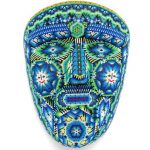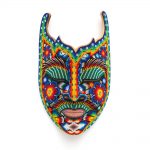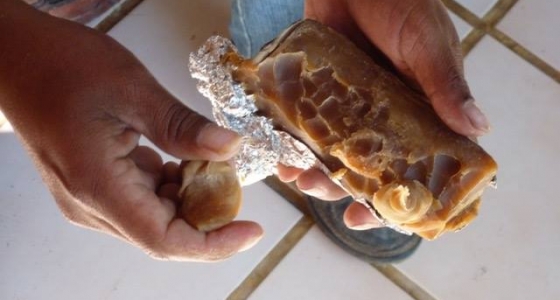Huichol art is more than just pretty objects. Prayer bowls, beaded animals, masks, and ceremonial objects use sacred symbols that represent the artist’s religious beliefs and culture.
Huichol Indians (pronounced Wee-chol) live in the Sierra Madre Occidental mountains northeast of Puerto Vallarta, in the states of Jalisco and Nayarit.
Their art is a reflection of their intensely personal religious culture. In the words of legendary anthropologist Carl Lumholtz:
Religion to them is a personal matter, not an institution, and therefore their life is religious from the cradle to the grave and wrapped up in symbolism.”
Symbolism in Huichol Art
Beautiful, intricate yarn paintings, beaded animal carvings, prayer bowls and masks all display the deep symbolism of the Huichol religious belief, which is centered around their “holy trinity” of the deer (maxra), maize (iku), and peyote (hikuri). Visions are often inspired by the peyote that allow the Huichols to communicate with their gods. These visions are reflected in their art and in their offerings to the gods. We include information on Huichol symbolism and the artists with each piece of Huichol art you purchase.
Huichol Lore and History
Many researchers have recorded Huichol lore and history. Here are some links to some of this research:
Example of Huichol symbolism
Huichol depiction of the Creation, beeswax and yarn, Mexico pic.twitter.com/QgG4CGruIo
— Art for everyone (@RobertFehr3) March 16, 2015
Why the art we sell is different
At Cosas Bonitas Oregon we bring you this very special beaded Huichol art from Mexico. The art and jewelry we offer is created using size 15 seed beads, which are much smaller than the size 11 beads used in most other Huichol art. The smaller beads are supplied to the artists since they are not usually available in Mexico.
The smaller beads allow the artists to create amazingly detailed art that you can’t find anywhere else. The intricate designs are painstakingly created by our artisans, and every bead is always perfectly in place.
The smaller beads allow the artists to include much more detail in the pieces; this art will amaze you! The designs are extremely intricate and every bead is always perfectly in place. See the comparison of Huichol beading done with size 11 (larger) seed beads on the left and size 15 (smaller) seed beads on the right. The larger sized beads fit only 9 beads per inch, while the smaller beads fit 15 beads to the inch, yielding much finer detail. All of the Huichol art we carry is created using the smaller size of seed beads, including the jewelry.

Supporting Huichol Artists
The art we offer is created by a particular group of families from the Huichol indigenous group of Mexico. The families have participated in a fair trade relationship for almost two decades to produce pieces that are museum and gallery quality.
An issue common in traditional cultures is that the younger people must often leave to find employment. But our artists are able to have employment, stay in their homes, so their culture and close family structure is maintained.
The colorful and intricate designs reflect the Huichol culture and religion. Rich in tradition and mysticism, each piece of art is a unique treasure. The beads, wooden carvings, gourd bottoms (in the case of prayer bowls) and beeswax mixture are all supplied to the artists.
We offer this art at very reasonable prices as part of our commitment to creating a sustainable market for the artists and their families.
Read about our commitment to Fair Trade.
Huichol Use of the Beeswax
A beeswax mixture is used as the adhesive in both the beaded art and yarn paintings. A very thin coating of beeswax mixture is applied to the surface of a wooden carving, to a board (for yarn paintings) or to the inside of a gourd (for prayer bowls). Beads are then applied using a needle full of beads in the colors that the artist needs for an area. The beads stay in place permanently with gentle handling of the piece.
NOTE: Keep the piece out of direct, hot sunlight and use a gentle touch on the surface so as not to press the beads, causing a "bruise."















Follow Latin American Art Gallery